Life style
Don’t shun sunshine Vitamin

While most of us avoid the hot sun at noon, we deprive ourselves of ‘Sunshine Vitamin’ or Vitamin D which is at its peak during that time of the day. In an interview with the Sunday Island, Head of the Department of Nutrition at the Medical Research Institute (MRI) and President of the Sri Lanka Medical Nutrition Association (SLMNA), Dr. Renuka Jayatissa throws light on the latest research which has unearthed new knowledge about this natural nutrient boosting our immunity which we often take for granted.
by Randima Attygalle
Known as ‘Sunshine Vitamin’, Vitamin D is produced by the body when the skin is exposed to sunlight. Vitamin D also functions as a hormone and every body cell has a receptor for it. Sun exposure at mid-day (from 10 a.m. to 3 p.m.) is the best way to boost vitamin D levels, says Head of Nutrition at the Medical Research Institute (MRI), Dr. Renuka Jayatissa. “Although morning sunlight was traditionally believed to be the best source of vitamin D, new knowledge confirms that 10 to 15 minutes of exposure to midday sun is the best time to make use of sunshine. The exposure becomes even more important as dietary intake of vitamin D is not sufficient.
The findings of local research speak for the changing nature of vitamin D intake, contrary to the popular belief that those from tropical nations are the most benefitted by this nature’s panacea. While the population from the Central and Sabaragamuwa Provinces are the most vulnerable to the deficiency due to the climatic patterns, the North Central Province is the least vulnerable given the hot climate of the region and the agrarian lifestyle. “The findings also reveal that 50% of adolescents of the country and nearly 95% of women are vitamin D deficient. This situation is alarming as it is a precursor to a host of other health issues including immunity problems, loss of bone density and muscle weakness,” explains Dr. Jayatissa who warns that COVID-19 pandemic has compounded the situation with restricted movement and children being home bound.
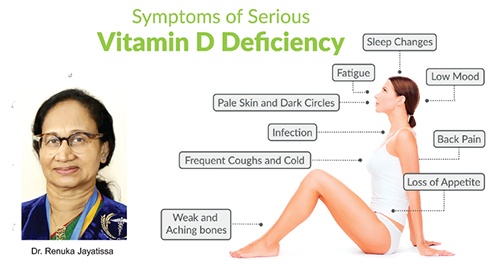 The vitamin D intake from the sun depends on the degree of exposure to sunlight. “If you wear long sleeved shirts/ blouses and trousers, it is most likely that you will get only about 10% of exposure with only your face and neck exposed. However if you wear a short-sleeved shirt/blouse and a mid-length skirt or a frock, you will get about 30% exposed,” points out the physician. “What is recommended is about 10 to 15 minutes of exposure daily. However, overweight people and those with a darker skin complexion will require more. While peak period is between 12 noon to 1 p.m. in the afternoon, ironically this is the time that most Sri Lankans tend to avoid the sun, given the humidity of the environment, says Dr. Jayatissa.
The vitamin D intake from the sun depends on the degree of exposure to sunlight. “If you wear long sleeved shirts/ blouses and trousers, it is most likely that you will get only about 10% of exposure with only your face and neck exposed. However if you wear a short-sleeved shirt/blouse and a mid-length skirt or a frock, you will get about 30% exposed,” points out the physician. “What is recommended is about 10 to 15 minutes of exposure daily. However, overweight people and those with a darker skin complexion will require more. While peak period is between 12 noon to 1 p.m. in the afternoon, ironically this is the time that most Sri Lankans tend to avoid the sun, given the humidity of the environment, says Dr. Jayatissa.
“The school interval is limited only to half an hour and this too during mid-morning. As most children may take their first meal for the day during the interval, there is hardly time for play,” observes the nutrition specialist. Recommendations have already being made to the School Committees of the Education Ministry to give children another mid-day break so that they are exposed to the peak period of sun, says Dr. Jayatissa. “Vitamin D is crucial for children on the threshold of puberty (10-15 years) as it affects growth and immunity.”
The rising elderly population in the country too calls for interventions to mitigate vitamin D deficiency as fractures are a common repercussion. Vitamin D deficiency can lead to a loss of bone density which in turn can cause osteoporosis and fractures. “With the elderly population multiplying in years, disability will be an added burden,” warns Dr. Jayatissa. Vitamin D is crucial for calcium absorption and bone metabolism. Low bone density results in loss of calcium and other minerals in bones. Older adults, especially women are at an increased risk of fractures due to this.
Risk factors for vitamin D deficiency are many. Besides lack of exposure to sunlight, having dark skin, being overweight or obese, being elderly, lack of dairy and fish in diet, excessive use of sun screen are among them. “Obesity is a risk factor for the deficiency as increased fat cells in the body require larger doses of vitamin D,” observes the physician who goes onto note that lifestyle patterns too trigger the condition. “Although those who live far from the equator are traditionally considered to be lacking vitamin D, their understanding of this drives them to be exposed to the sun as much as possible. Walking or cycling to work, walking to a cafeteria, traveling to tropical regions during summer etc. push them to bridge the gap. Ironically in our part of the world, apart from farmers and other workers such as those in the construction industry and the manual labour force, people are deprived of sun exposure.”
Since symptoms of vitamin D deficiency are often subtle, many people will not realize that they are lacking it. “However this could affect the quality of life,” remarks Dr. Jayatissa. Height gain is seriously threatened by the condition, she says. “Compared to taller communities such as the Dutch whose average height for males is about 180 cm, Sri Lankan average height is about 168 for men and 153 for women. This may even decrease in time to come, unless the situation is urgently addressed”. Sun exposure as the vitamin D booster cannot be undermined, especially because very few foods such as fish, fish liver oils, egg yolks and fortified dairy and grain products contain vitamin D, notes the nutrition specialist.
Keeping the immune system strong is one of the key roles of vitamin D. During the pandemic, this becomes even more valid as a strong immune system can fight off viruses and even bacteria that cause illness. Studies have confirmed that vitamin D can reduce the risk of respiratory tract infections. “Migraines in young people could also be a cause of the deficiency and muscle cramps in the night among the elderly could also be a strong symptom,” points out Dr. Jayatissa. Bone and back pain, impaired wound healing and even low moods are among the other symptoms.
Certain studies have also found that vitamin D can help treat skin conditions such as psoriasis and eczema. While sunshine can do wonders to your skin and body, too much of it can be risky, points out the physician. “Sun spots as a result of sunburn, skin aging, heat stroke and skin cancer are among them.” Administering vitamin D supplements should always be done on clinical advise as vitamin D toxicity entails its own dangers, concludes Dr. Jayatissa.
- News Advertiesment
See Kapruka’s top selling online shopping categories such as Toys, Grocery, Flowers, Birthday Cakes, Fruits, Chocolates, Clothing and Electronics. Also see Kapruka’s unique online services such as Money Remittence,News, Courier/Delivery, Food Delivery and over 700 top brands. Also get products from Amazon & Ebay via Kapruka Gloabal Shop into Sri Lanka.
Life style
LUXASIA aims to lead luxury beauty’s growth in Sri Lanka
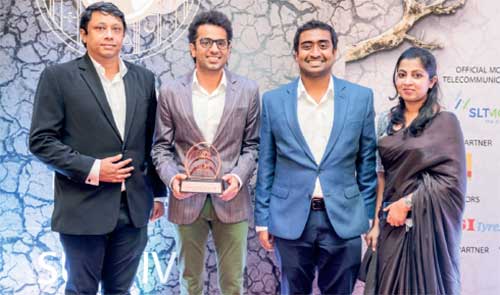
Sri Lanka is a land renown for stunning natural beauty. Yet, LUXASIA still managed to usher in a different kind of beautiful to the market through its expertise in luxury beauty retail and omni-distribution.
In November 2019, LUXASIA unveiled its inaugural classy beauty counters at Odel, One Galle Face. Since then, it has brought enchanting fragrances from luxury brands such as Burberry, Calvin Klein, Gucci, and Marc Jacobs, as well as trendy skincare from KORA Organics to beauty-lovers in an exquisite and captivating retail format.
Now, having successfully overcome the challenges in 2020 imposed by COVID-19 and related lockdowns, LUXASIA is ready and excited to thrill Sri Lankan consumers again. This time, it is with the launch of both skincare and make-up collections from the prestigious Japanese beauty brand, Shiseido. Arriving with a glamorously magnificent pop-up at One Galle Face from 8 to 14 February 2020, LUXASIA promises to bring memorable consumer experiences and a feast for the eyes that showcases the best in Japanese beauty.
Leading up to this pop-up, LUXASIA partnered the Key Opinion Leaders (KOLs) and top influencers of Sri Lanka to excite the beauty community with a sneak peek of what Shiseido have to offer. This campaign garnered more than 100,000 social interactions, with over 1.2 million social media impressions, piquing consumers’ fascination in Shiseido’s award-winning and best-selling serum, The Ultimune Power Infusing Concentrate.
Looking ahead into 2021, LUXASIA aims to continue delighting consumers with even more fresh retail innovations to spice up the luxury beauty scene in Sri Lanka. Soon, fragrance enthusiasts can expect a unique pop-up of all the scents that Luxasia carry, featuring new launches from Davidoff and Calvin Klein, as well as other interesting novelties. Beauty-lovers can also expect more limited edition products and gifts-with-purchases, interesting workshops, as well as seasonal offerings in the coming months. Concurrently, LUXASIA also aspires to continue grooming the Sri Lankan beauty community through more entertaining collaborations with KOLs throughout 2021.
LUXASIA sees immense potential in Sri Lanka’s fast-growing beauty market and has been its voice in the international beauty industry. For some time now, LUXASIA has been relentlessly reaching out to numerous luxury beauty brands across to world to interest them in Sri Lanka. While it is encouraging to see the first-fruits, LUXASIA is aiming much higher. Forging ahead, LUXASIA strives to champion and lead the growth of luxury beauty in Sri Lanka, through even more partnerships with great brands, and by continuously delighting consumers.
Life style
Newly published guide opens many windows on whale watching
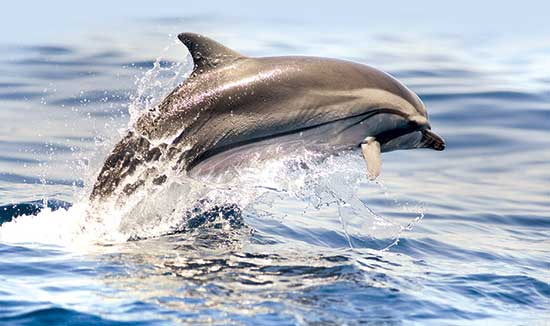
by Ifham Nizam
Shipping lanes to the south of Dondra pose the threat of ships colliding with whales as the area has very rich marine life which also attracts whale watching boats, says prolific wildlife writer and photographer Gehan de Silva Wijeyeratne, author of the recently published ‘A Naturalist’s Guide to the Mammals of Sri Lanka’.
He says international shipping industry organizations have written to the government to push back the existing shipping lanes and if no action is initiated, there is the danger of whale watching boats colliding with vessels.
Dr. Susannah Calderon and her colleagues at the University of Ruhuna have recommended the shipping lanes be moved 15 nautical miles south. The cost impact to all concerned will be negligible, but it significantly improves safety at sea, especially at night when the sea is dotted with the lamps from hundreds of small fishing crafts in the path of giant container carriers.
“It is primarily a safety issue though an important secondary impact will be that it reduces fatal collisions with whales, while generating favourable publicity for the government of Sri Lanka. It boils down to moving the shipping lanes further south and saving lives, Wijeyeratne stressed in an interview with The Sunday Island.
Asked what’s special about his latest publication, he said: “This is the first photographic field guide which covers nearly all of the mammals found in Sri Lanka. It covers 96 per cent of the land and marine mammals. The book, which is portable and affordable, also contains a large number of images from 40 photographers which are practically useful in the field to identify 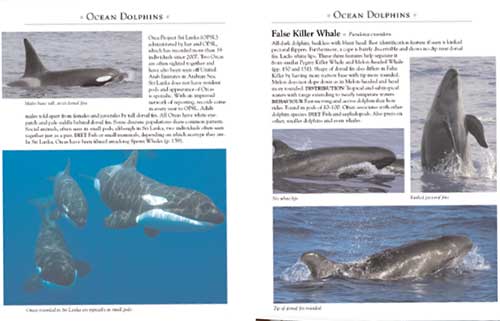 a mammal to species level. It also covers a number of small, discrete, nocturnal mammals whose existence that even many local wildlife enthusiasts will not be aware of.”
a mammal to species level. It also covers a number of small, discrete, nocturnal mammals whose existence that even many local wildlife enthusiasts will not be aware of.”
On the book’s coverage of the marine mammals, Wijeyeratne said there are two noteworthy aspects. Firstly, it covers all the species recorded in Sri Lankan waters expect for one, the Omura’s Whale. This will be included in a second edition. Secondly, it uses images of the whales and dolphins (cetaceans) which will show the animals the way a whale watcher will see them on the surface.
Artwork that shows the whole animal is important, but in field conditions, they are often of limited value to identify cetaceans which only show a little of their upper body in sections at a time they surface.
Q: You were the first to publicize that Sri Lanka was the best location for Blue Whale sightings and offered the best chance to see a superpod of Sperm Whales. Can you explain briefly how you set about branding Sri Lanka as a top international destination for whale watching?
A:
I started with field work to ascertain the facts and launched a media campaign initially with Jetwing Eco Holidays and Jetwing Hotels which was supported over many years by the Sri Lanka Tourism Promotion Bureau (SLTPB) and others in the media and tourism business. I have published 37 articles on whale watching in Sri Lanka. The first, in May 2008, was pivotal as it boldly stated that Sri Lanka was best for Blue Whales. This set everything in motion. My articles give due credit to many people who were a part of this amazing story. This includes Dr. Charles Anderson who first told me it would be feasible to see Blue Whales from the South.
A Belgian millionaire philanthropist who prefers to remain anonymous and helped create the infrastructure for whale watching by 13 tsunami affected fishing youth who set up Mirissa Water Sports and Sue Evans who was important for connecting all of us and Anoma Alagiyawadu (the Jetwing Lighthouse Naturalist) whom I tasked with collecting the initial data for the Encounter Rates I publicized in the media.
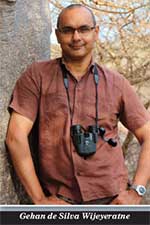 Remarkably, no Sri Lankan marine biologist played any role in publicizing whale watching in the early years. However, soon after, they benefited by being thrust into the media spotlight by film crew researchers who had read the publicity which began with my various widely disseminated articles. Having read them, and sometimes after conversations with me, the film crews and the press came to Sri Lanka and incorporated local marine biologists into their story.
Remarkably, no Sri Lankan marine biologist played any role in publicizing whale watching in the early years. However, soon after, they benefited by being thrust into the media spotlight by film crew researchers who had read the publicity which began with my various widely disseminated articles. Having read them, and sometimes after conversations with me, the film crews and the press came to Sri Lanka and incorporated local marine biologists into their story.
At the time I broke the first story, I do not think any of the local marine biologists had even one image of a Blue Whale of a publishable standard or had any idea that Sri Lanka was the best place in the world to see Blue Whales. Hopefully, the increased profile of local marine biologists has made it easier for them to raise the funds needed for their important research.
Q: Did the Sri Lanka Tourism Promotion Bureau help your efforts with publicity and branding?
A:
Yes indeed. At the start of the publicity campaign, we produced a series of informative and attractive publications designed by Chandrika Maelge. These were printed and distributed at key consumer and travel trade fairs such as the Bird Fair, WTM and Destinations where a number of important press and tour operators were informed about Sri Lanka being a good place for whales. At some of the press drinks events in London hosted by Jetwing Eco Holidays, around 35-45 press people would attend. These events were held in collaboration with the London Office of the SLTPB.
In some years, As many as three of these press events were held allowing personal interaction with a wide pool of media people. Another important and later development is the role played by Nalin Perera who ran the SLTPB office in London for several years and attended many consumer and travel trade fairs. I had developed media briefs for him which he would print and distribute. In one conversation, he estimated that he had printed and distributed over 10,000 copies of this material.
There were others who also disseminated my stories to the international press; a notable example being Chitral Jayatilake who shared my publicity pdfs with various wildlife documentary makers he invited to Sri Lanka.
Q: Did everyone readily embrace your ideas?
It took a couple of years. I remember even into the second year of the publicity campaign there were doubts from the big companies in tourism.
I remember Srilal Miththapala who was then President of The Hotels Association of Sri Lanka speaking to me and joining a celebrity whale watching event I was leading with Shyamalee Tudawe. This was organized by Olivia Richli of the Amangalla in Galle.
Srilal wanted to report back to the association if there was any truth to the claims being made by me about how easy it was to see Blue Whales. On the coastline, the people running small guesthouses readily embraced the story as tourists who were reading my stories turned up with copies of my articles and asked for boats to take them whale watching. The international press also readily took it on as I provided credible data.
Q: What do you say to criticisms that whale watching needs better regulation?
I agree on the need for better regulation and higher standards. The tourism industry has played its part in publicizing whale watching. Other state agencies also need to step up their efforts to regulate the industry in a way that is good for the welfare of the animals and provide a good visitor experience.
Q: What do you expect ‘A Naturalist’s Guide to the Mammals of Sri Lanka’ to achieve?
I would like people to understand that there is still a lot to be discovered about Sri Lanka’s mammals and I hope this portable and affordable guide will find its way into the hands of local naturalists and inspire more research and more practical steps to conserve habitats and species.
Life style
Modern Brides and Grooms collection by LOVI Ceylon and friends

Brides and Grooms of Sri Lanka – Reimagined
“Together we’re creating moments of happiness and cherished memories for the new couple and their families” said Founder and CEO of LOVI Ceylon, Asanka de Mel, as he introduced LOVI Ceylon’s Groom collection. Each groom’s look was paired with extraordinary creations from Sri Lanka’s top bridal designers, jewelers, florists, hair and make-up artiste and was captured by story-telling photographers.
The presentation graciously hosted by the Taj Samudra and Shangri-La hotels saw 30 leading designers working hand in hand to infuse fresh ideas, celebrate cultural diversity and show-off Sri Lankan couture—the island’s hand craft heritage.
The stunning bridal costumes were painstakingly made by renowned designers Messrs. Dhananjaya Bandara, Rishard Raheem, and Michael Wijesuriya as well as Mses. Indi Yapa Abeywardena of Brides by INDI, Sonali Dharmawardena, Darshi Keerthisena of Buddhi Batiks, Ramona Oshini, Sandani Perera of IKIGAI Bridal, and Jaish Parathalingam of Aashkii. The newcomer, Ms. Anusha David also presented her couture creations under the label Gabriel.
“We want our Groom and all of the men in the wedding including the groomsmen, dads, young boys and friends, to be themselves–to feel rooted in culture, well dressed and at ease on the wedding day,” says Asanka. Celebrating the religious and cultural traditions including Buddhist, Christian, Hindu, Kandyan, Malay, Muslim, Sinhala, Tamil and western traditions of the island LOVI Ceylon’s Grooms’ range presented modern sarongs paired with formal shirts, jackets, kurtas and more. They were paired with sarees, dresses, lehengas, pant suits and an array of breathtaking outfits. There were many looks offered for the Sri Lankan diaspora, as well as couples seeking inspiration for destination weddings.
As the designs progressed from sketch to stitching, our jewelry partners Careems, Lalitha, Mallika Hemachandra, Tiesh and Vogue jewelers added their brilliant sparkles with handcrafted fine jewelry made of precious metals encrusted with diamonds, sapphires and rubies. And what wedding would be complete without flowers? Bringing the latest floral creations were florists Designer Flowers, Flowers by Joan and Karen Forbes, Lassana Flora, and Supreme Flora who made the spectacular bridal outfits blossom with their creations.
Breathing life into these wonderful creations with superb hair and make-up was anchor of the shoot, Ms. Nadiya Fernando and her collaborator Omesh, while Ramani Fernando Salons, Shane Perera, Viran Peter, Brides by Leena and Talia designs, also worked magic on the models.
The father son duo Dinuka and Dineth Fonseka of Studio3000 took on the herculean task of capturing all the creations as the anchor photography partner. The works of Ashene Bernard, Amarante Studio, Geeshan Bandara, and Portrait Culture were also presented in imaginative and artistic captures.
De Mel expressed his thanks to the wonderful models who brought the visions and fancies of the designers to life, as well as poet and author Ashok Ferrey for being the MC of the shoot and providing an eloquent commentary, delivered with his inimitable panache!
“We have world class craftsmanship here, it’s fun to work with so many experts, who just happen to be friends, to present a beautiful collection that could nudge the course of Sri Lankan clothing identity” said Asanka when asked about the work that went into this.
As he rightly reminded the gentlemen to choose wisely, “on that special wedding day, when all eyes are on her–her eyes are on you!”









